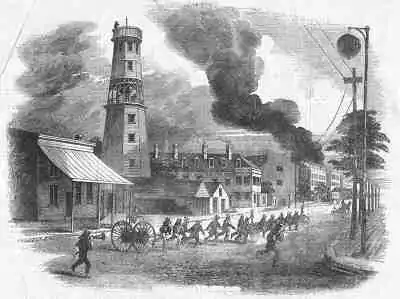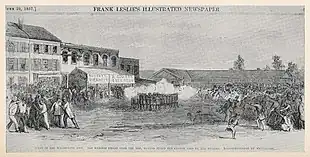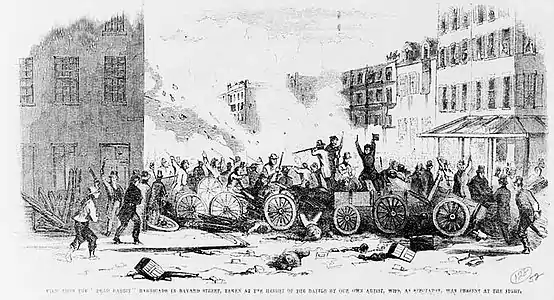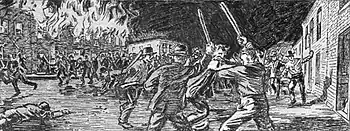Know-Nothing Riot
The term Know-Nothing Riot has been used to refer to a number of political uprisings of the Nativist American Know Nothing Party in the United States of America during the mid-19th century. These anti-immigrant and anti-Catholic protests culminated into riots in Philadelphia in 1844, St. Louis in 1854, Cincinnati and Louisville in 1855, Baltimore in 1856, Washington, D.C., and New York in 1857, and New Orleans in 1858.
_7th_1844_-_H._Bucholzer._LCCN2003654121.jpg.webp)



Know-Nothing Riots (1844–1858)
Philadelphia
Cincinnati
The Election Day Riots of 1855 occurred in Cincinnati between April 2–7, 1855. The election was between James J. Faran, the Democratic contender and editor of the Cincinnati Enquirer, and James D. Taylor, rabid nativist editor of the Cincinnati Times. Rumors of illegal voting, ballot-box stuffing, and naturalized voters preventing native-born citizens from voting sparked the events. [1]
Louisville
See Bloody Monday.
Baltimore
Washington D.C.
Know-Nothing associated gang, the Plug Uglies, had travelled to Washington. D.C.. from Baltimore on June 1, 1857, in an attempt to prevent German and Irish immigrants from voting in the local election. The Plug Uglies linked up with allied members of the Rip Raps and the Chunkers and moved to Mount Vernon Square to harass anti-Know Nothing voters. They then returned to the square armed with pistols, clubs, bricks, and other weapons and charged into the crowd of voters. A brutal fight broke out which the police were unable to stop and by noon, President Buchanan had called out two companies of Marines to stop the riot. By the time the Marines arrived at Mount Vernon Square, the Know-Nothings had set up a barricade and were armed with a cannon they had taken from the Navy Yard. Archibald Henderson, Commandant of the Marine Corps, marched up to the cannon and placed his body in front of it so it could not be aimed at his men. This allowed the Marines to advance on their position, but a fire fight soon broke out. Eight People were killed by the end of the day and many more were injured.[2]
New York City
New Orleans
The New Orleans Know-Nothing group began as a local movement in 1858 to reduce what residents considered a high rate of crime and violence in the city, primarily among Irish and German immigrants, who were among the poorest classes. A secret Vigilance Committee was formed to monitor their activities, and in particular to prevent disruption of upcoming municipal elections.
On the night of June 2, 1858, armed men under the command of Capt. J.K. Duncan, an officer in the United States Army, marched to Jackson Square and occupied the court rooms in The Cabildo. For the next five days, a standoff existed between the Vigilance Committee and members of the Native American Party. On June 7, the elections were held and the Native American candidate, Gerard Stith, defeated the Democratic Party candidate, P.G.T. Beauregard. The Vigilance Committee disbanded with no further violence.[3]
Notable Know Nothing criminal gang rioters
- American Guards (New York City)
- Atlantic Guards (New York City)
- Blood Tubs (Baltimore and Philadelphia)
- Bowery Boys (New York City)
- Killers (Philadelphia)
- O'Connell Guards (New York City)
- Plug Uglies (Baltimore, Philadelphia, and New York City)
- Rip Raps (Baltimore)
- Roach Guards (New York City)
- Shifflers (Philadelphia)
See also
References
- E., Gienapp, William (1987). The origins of the Republican Party, 1852-1856. Frank and Virginia Williams Collection of Lincolniana (Mississippi State University. Libraries). New York: Oxford University Press. ISBN 0195041003. OCLC 13425951.
{{cite book}}: CS1 maint: multiple names: authors list (link) - "The Election Day Riot of 1857, driven by religious intolerance". Retrieved 2021-12-08.
- "New-Orleans Vigilance Committee - Tems of Settlements", nytimes.com, June 4, 1858.
Sources
- Melton, Tracy Matthew (2005). Hanging Henry Gambrill: The Violent Career of Baltimore's Plug Uglies, 1854-1860. ISBN 0938420933.
- Smith, John Kendall (1922). A History of New Orleans. Chicago: Lewis Pub. Co.
